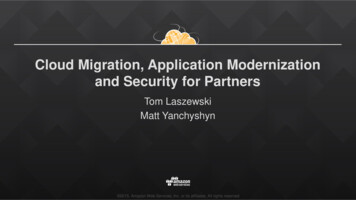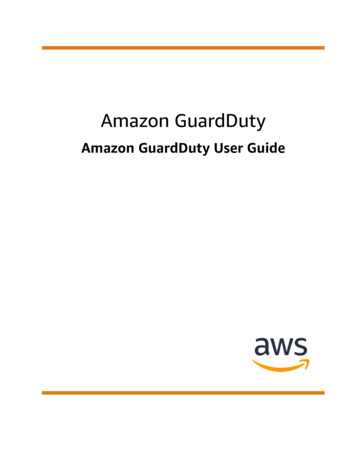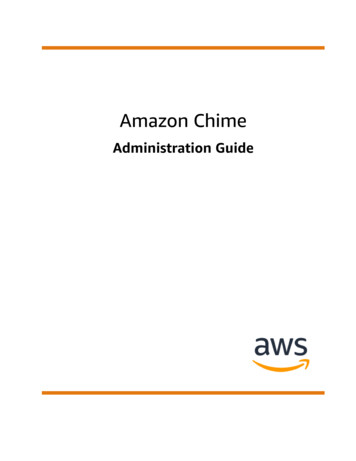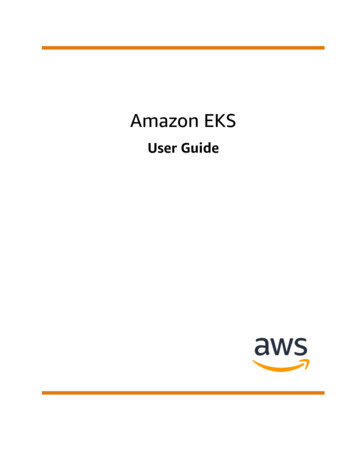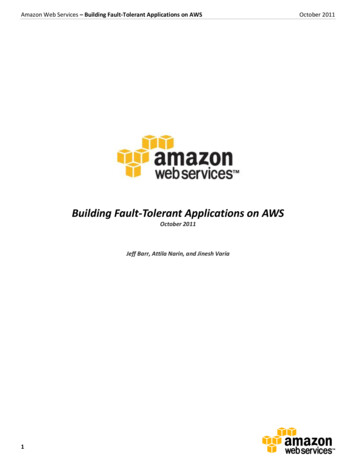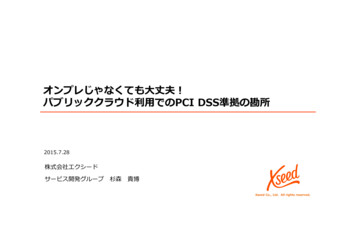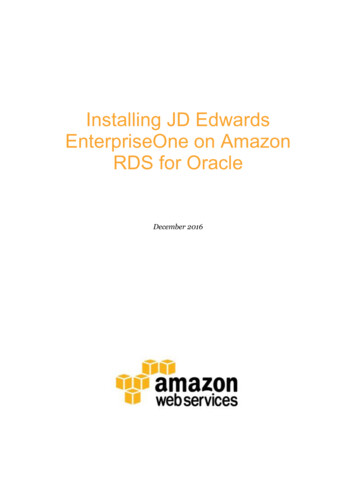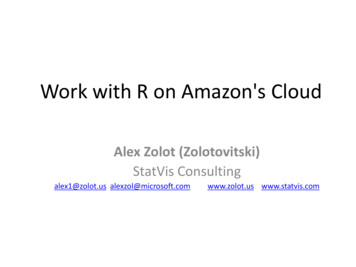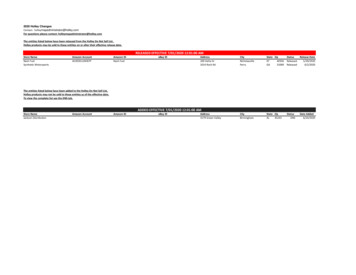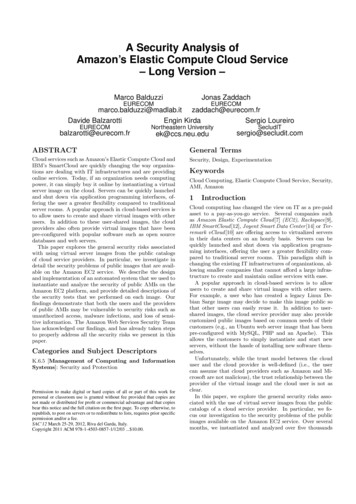
Transcription
A Security Analysis ofAmazon’s Elastic Compute Cloud Service– Long Version –Marco BalduzziJonas ZaddachEURECOMEURECOMmarco.balduzzi@madlab.it zaddach@eurecom.frDavide BalzarottiEngin KirdaSergio LoureiroEURECOMbalzarotti@eurecom.frNortheastern mABSTRACTGeneral TermsCloud services such as Amazon’s Elastic Compute Cloud andIBM’s SmartCloud are quickly changing the way organizations are dealing with IT infrastructures and are providingonline services. Today, if an organization needs computingpower, it can simply buy it online by instantiating a virtualserver image on the cloud. Servers can be quickly launchedand shut down via application programming interfaces, offering the user a greater flexibility compared to traditionalserver rooms. A popular approach in cloud-based services isto allow users to create and share virtual images with otherusers. In addition to these user-shared images, the cloudproviders also often provide virtual images that have beenpre-configured with popular software such as open sourcedatabases and web servers.This paper explores the general security risks associatedwith using virtual server images from the public catalogsof cloud service providers. In particular, we investigate indetail the security problems of public images that are available on the Amazon EC2 service. We describe the designand implementation of an automated system that we used toinstantiate and analyze the security of public AMIs on theAmazon EC2 platform, and provide detailed descriptions ofthe security tests that we performed on each image. Ourfindings demonstrate that both the users and the providersof public AMIs may be vulnerable to security risks such asunauthorized access, malware infections, and loss of sensitive information. The Amazon Web Services Security Teamhas acknowledged our findings, and has already taken stepsto properly address all the security risks we present in thispaper.Security, Design, ExperimentationCategories and Subject DescriptorsK.6.5 [Management of Computing and InformationSystems]: Security and ProtectionPermission to make digital or hard copies of all or part of this work forpersonal or classroom use is granted without fee provided that copies arenot made or distributed for profit or commercial advantage and that copiesbear this notice and the full citation on the first page. To copy otherwise, torepublish, to post on servers or to redistribute to lists, requires prior specificpermission and/or a fee.SAC’12 March 25-29, 2012, Riva del Garda, Italy.Copyright 2011 ACM 978-1-4503-0857-1/12/03 . 10.00.KeywordsCloud Computing, Elastic Compute Cloud Service, Security,AMI, Amazon1IntroductionCloud computing has changed the view on IT as a pre-paidasset to a pay-as-you-go service. Several companies suchas Amazon Elastic Compute Cloud [7] (EC2), Rackspace[9],IBM SmartCloud [12], Joyent Smart Data Center [14] or Terremark vCloud [10] are offering access to virtualized serversin their data centers on an hourly basis. Servers can bequickly launched and shut down via application programming interfaces, offering the user a greater flexibility compared to traditional server rooms. This paradigm shift ischanging the existing IT infrastructures of organizations, allowing smaller companies that cannot afford a large infrastructure to create and maintain online services with ease.A popular approach in cloud-based services is to allowusers to create and share virtual images with other users.For example, a user who has created a legacy Linux Debian Sarge image may decide to make this image public sothat other users can easily reuse it. In addition to usershared images, the cloud service provider may also providecustomized public images based on common needs of theircustomers (e.g., an Ubuntu web server image that has beenpre-configured with MySQL, PHP and an Apache). Thisallows the customers to simply instantiate and start newservers, without the hassle of installing new software themselves.Unfortunately, while the trust model between the clouduser and the cloud provider is well-defined (i.e., the usercan assume that cloud providers such as Amazon and Microsoft are not malicious), the trust relationship between theprovider of the virtual image and the cloud user is not asclear.In this paper, we explore the general security risks associated with the use of virtual server images from the publiccatalogs of a cloud service provider. In particular, we focus our investigation to the security problems of the publicimages available on the Amazon EC2 service. Over severalmonths, we instantiated and analyzed over five thousands
Linux and Windows images provided by the Amazon catalog, checking for a wide-range of security problems such asthe prevalence of malware, the quantity of sensitive data lefton such images, and the privacy risks of sharing an imageon the cloud.In particular, we identified three main threats related, respectively, to: 1) secure the image against external attacks,2) secure the image against a malicious image provider, and3) sanitize the image to prevent users from extracting andabusing private information left on the disk by the imageprovider. For example, in our experiments we identifiedmany images in which a user can use standard tools to undelete files from the filesystem, and recover important documents including credentials and private keys.Although public cloud server images are highly useful fororganizations, if users are not properly trained, the risk associated with using these images can be quite high. The factthat these machines come pre-installed and pre-configuredmay communicate the wrong message, i.e., that they canprovide an easy-to-use “shortcut” for users that do not havethe skills to configure and setup a complex server. The reality is quite different, and this paper demonstrates that manydifferent security considerations must be taken into accountto make sure that a virtual image can be operated securely.During our study we had continuous contact with theAmazon Web Services Security Team. Even though Amazonis not responsible of what users put into their images, theteam has been prompt in addressing the security risks identified and described in this paper. Meanwhile, it has published public bulletins and tutorials to train users on howto use Amazon Machine Images (AMIs) in a secure way [29,28]. A more detailed description of the Amazon feedback isprovided in Section 6.Finally, it is important to note that the security problemswe describe in this work are general in nature, and theyare not specific to the Amazon Cloud. We hope that ourpaper will raise awareness about the security risks of usingand creating public software images on the cloud, and willencourage other cloud providers to verify and improve theirsecurity just as Amazon has done.In summary, this paper makes the following contributions: We describe the design and implementation of an automated system that is able to instantiate and analyzethe security of public AMIs on the Amazon EC2 platform. We provide detailed descriptions of the security teststhat we performed on public AMIs. We describe the results of our security tests that demonstrate that both the users and the providers of publicAMIs may be vulnerable to security risks such as unauthorized access, malware infections, and loss of sensitive information. The Amazon Web Services Security Team has acknowledged and taken steps to address the issues we haveidentified. We discuss the countermeasures that theyhave taken, and report on the information campaignsthat they have started.2Overview of Amazon EC2The Amazon Elastic Compute Cloud (EC2) is an Infrastructureas-a-Service cloud provider where users can rent virtualizedservers (called instances) on an hourly base. In particular,each user is allowed to run any pre-installed virtual machineimage (called Amazon Machine Image, or AMI ) on this service. To simplify the setup of a server, Amazon offers anonline catalog where users can choose between a large number of AMIs that come pre-installed with common servicessuch as web servers, web applications, and databases. AnAMI can be created from a live system, a virtual machineimage, or another AMI by copying the filesystem contents tothe Amazon Simple Storage Service (S3) in a process calledbundling. Public images may be available for free, or may beassociated with a product code that allows companies to billan additional usage cost via the Amazon DevPay paymentservice. Thus, some of these public machines are providedby companies, some are freely shared by single individuals,and some are created by the Amazon team itself.In order to start an image, the user has to select a resourceconfiguration (differing in processing, memory, and IO performance), a set of credentials that will be used for login, afirewall configuration for inbound connections (called a security group), and the region of the data center in which themachine will be started. Amazon data centers are currentlylocated in the US (Northern Virginia and Northern California), Europe (Ireland), and Asia (Singapore). An additionaldata center (Tokyo) was added after we had completed ourexperiments. Hence, this data center will not be discussedin the rest of the paper.Currently, there are three different pricing models available: The first one is a fixed pricing scheme where the customer pays per instance-hour, the second one is a subscription model with an initial fee and lower instance-hour costs,and the third one (called spot instances) is a model whereprices vary according to the current load of the data centers. This model lets the customer specify a maximum pricehe is willing to pay for an instance in addition to the otherinstance parameters. If the current spot price drops belowthis threshold, the instance is started, and if the spot pricerises above the threshold, it is terminated, thus making thismodel suitable for interruptible tasks.When an AMI is instantiated, its public DNS address isannounced via the Amazon API, and the machine is madeaccessible via SSH on port 22 (Linux) or Remote Desktopon port 3389 (Windows). An important aspect of this cloudcomputing service is that the instance’s maintenance is completely under the responsibility of the user. That is, she isthe one who can be held responsible for any content providedby the machine, and she is the one who has to assure its security. This includes, for example, the usual administrationtasks of maintaining the configuration in a secure state (i.e.,applying patches for vulnerable software, choosing the rightpasswords, and firewall configuration), and only allowing secure, encrypted communication protocols.3AMI Testing MethodologyTo conduct our security evaluation, we developed an automated system to instantiate and test the Amazon’s AMIs.The architecture of our system is highlighted in Fig. 1, andconsists of three main components. The Robot is the partof the system that is responsible for instantiating the AMIs,and fetching the corresponding login credentials. Since Amazon does not control which credentials are configured in thepublic images, our tool was configured to try a list of themost common user names (e.g., root, ec2-user, ubuntu,
Instanciate AMIAMIsRobotCheck LoginCredentialsInstantiated AMIDataDBAnalysisResultsRemote ScannerLocal ScannerTest SuiteScanUpload / ExecuteVulnerabilityConfigurationFigure 1: System Architectureand bitnami for Linux). Despite these attempts, there arecases in which the robot may fail to retrieve the correct logininformation. This is the case, for example, for AMIs whosecredentials are distributed only to the image provider’s customers by companies that make business by renting AMIs.Hence, these type of images are outside the scope of ourevaluation.After an AMI has been successfully instantiated by therobot, it is tested by two different scanners. The RemoteScanner collects the list of open ports1 using the NMap tool [23],and downloads the index page of the installed web applications. In Section 5, we explain how an attacker can usethis information as a fingerprint to identify running images.The Local Scanner component is responsible for uploadingand running a set of tests. The test suite to be executedis packaged together in a self-extracting archive, uploadedto the AMI, and run on the machine with administrativeprivileges. In addition, the Local Scanner also analyzes thesystem for known vulnerabilities using the Nessus tool [30].For AMIs running Microsoft Windows, the scripting of automated tasks is complicated by the limited remote administration functionalities offered by the Windows environment.In this case, we mounted the remote disk and transfered thedata using the SMB/Netbios subsystem. We then used thepsexec tool [27] to execute remote commands and invokethe tests.The test suite uploaded by the Local Scanner includes 24tests grouped in 4 categories: general, network, privacy, andsecurity (for the complete list see Appendix A).The general category contains tests that collect generalinformation about the system (e.g. the Linux distributionname, or the Windows version), the list of running processes,the file-system status (e.g., the mounted partitions), the listof installed packages, and the list of loaded kernel modules. In addition to these basic tests, the general categoryalso contains scripts that save a copy of interesting data,such as emails (e.g., /var/mail), log files (e.g., /var/logand %USER\Local Settings), and installed web applications(e.g., /var/www and HKEY LOCAL MACHINE\SOFTWARE).1Since Amazon does not allow external portscans of EC2machines, we first established a virtual private network connection to the AMI through SSH, and then scanned the machine through this tunnel.The privacy test cases focus on finding any sensitive information that may have been forgotten by the user thatpublished the AMI. This includes, for example, unprotectedprivate keys, application history files, shell history logs, andthe content of the directory saved by the general test cases.Another important task of this test suite is to scan thefilesystem to retrieve the contents of undeleted files.The network test suite focuses on network-related information, such as shared directories and the list of open sockets. These lists, together with the processes bound to thesockets, can be used to verify if the image is establishingsuspicious connections.Finally, the security test suite consists of a number ofwell-known audit tools for Windows and Linux. Some ofthese tools look for the evidence of known rootkits, Trojans and backdoors (e.g. Chkrootkit, RootkitHunter andRootkitRevealer), while others specifically check for processes and sockets that have been hidden from the user(PsTools/PsList and unhide). In this phase, we also runthe ClamAV antivirus software (see Section 4.2) to scan forthe presence of known malware samples.These security tests also contain checks for credentialsthat have been left or forgotten on the system (e.g., databasepasswords, login passwords, and SSH public keys). As already mentioned in an Amazon report published in June2011 [15], these credentials could potentially be used as backdoors to allows attackers to log into running AMIs.4Results of the AMIs AnalysisOver a period of five months, between November 2010 toMay 2011, we used our automated system to instantiate andanalyze all Amazon images available in the Europe, Asia,US East, and US West data centers. In total, the catalog of these data centers contained 8,448 Linux AMIs and1,202 Windows AMIs. Note that we were successfully ableto analyze in depth a total of 5,303 AMIs. In the remainingcases, a number of technical problems prevented our tool tosuccessfully complete the analysis. For example, sometimesan AMI did not start because the corresponding manifestfile was missing, or corrupted. In some cases, the runningimage was not responding to SSH, or Remote Desktop connections. In other cases, the Amazon API failed to launchthe machine, or our robot was not able to retrieve valid logincredentials. These problems were particularly common forWindows machines where, in 45% of the images, the Amazon service was not able to provide us with a valid usernameand password to login into the machine. Nevertheless, webelieve that a successful analysis of over 5,000 different images represents a sample large enough to be representativeof the security and privacy status of publicly available AMIs.Table 1 shows a number of general statistics we collectedfrom the AMIs we analyzed. Our audit process took on average 77 minutes for Windows machines, and 21 minutes forthe Linux images. This large difference is due to two mainreasons: first, Windows machines in the Amazon cloud takea much longer time to start, and, second, our antivirus testwas configured to analyze the entire Windows file-system,while only focused the analysis on directories containing executables for the Linux machines.In the rest of this section, we present and discuss the results of the individual test suites.
Windows77 min–323.92.75223.81.07 GBLinux21 min4165402.52624.82.67 GB302520# of AMIsAverage #/AMIAudit durationInstalled packagesRunning ProcessesSharesEstablished socketsListening socketsUsersUsed disk space15105Table 1: General Statistics0025913 17 22 28 33 37 41 45 51 55 59 65 69 79 90 99 10811 15 20 26 30 35 39 43 47 53 57 61 67 76 83 93 103 125# of VulnerabilitesSoftware VulnerabilitiesThe goal of this first phase of testing is to confirm the factthat the software running on each AMIs is often out of dateand, therefore, must be immediately updated by the userafter the image is instantiated.For this purpose, we decided to run Nessus [30], an automated vulnerability scanner, on each AMI under test. Inorder to improve the accuracy of the results, our testingsystem provided Nessus with the image login credentials, sothat the tool was able to perform a more precise local scan.In addition, to further reduce the false positives, the vulnerability scanner was automatically configured to run only thetests corresponding to the actual software installed on themachine. Nessus classifies each vulnerability with a severity level ranging from 0 to 3. Since we were not interestedin analyzing each single vulnerability, but just in assessingthe general security level of the software that was installed,we only considered vulnerabilities with the highest severity(e.g., critical vulnerabilities such as remote code execution).We also looked at the most common vulnerabilities thataffect Windows and Linux AMIs. These results are detailedin Appendix B.From our analysis, 98% of Windows AMIs and 58% ofLinux AMIs contain software with critical vulnerabilities.This observation was not typically restricted to a single application but often involved multiple services: an average of46 for Windows and 11 for Linux images (the overall distribution is reported in Figure 2). On a broader scale, weobserved that a large number of images come with softwarethat is more than two years old. Our findings empiricallydemonstrate that renting and using an AMI without anyadequate security assessment poses a real security risk forusers. To further prove this point, in Section 4.2, we describehow one of the machines we were testing was probably compromised by an Internet malware in the short time that wewere running our experiments.4.2Security RisksMalwareAs part of our tests, we used ClamAV [8], an open source antivirus engine, to analyze the filesystem on the target AMI.ClamAV contains about 850,000 signatures to identify different types of known malware instances such as viruses,worms, spyware, and trojans. Since most of the existingmalware targets the Windows operating systems, we analyzed the complete file-system tree of Windows AMIs, whilewe limited the coverage for Linux AMIs to common binarydirectories (e.g. /usr/bin, /bin, and /sbin). As a consequence, the scan time took on average of 40 minutes for a303503002525020# of AMIs4.12001515010100550002 4 910 131617 2222 2828 3433 4037 4641 4552 5158 5564 5970 657669 8279 8890 9499 10010801 5 7 1113 151920 2526 3130 3735 4339 4349 4755 5361 5767 6173 67 7976 8583 9193 97103 103125# of VulnerabilitesFigure 2: Distribution AMIs / Vulnerabilites (Windows and Linux)Windows installation, and less then a minute for a Linuxone.In our malware analysis, we discovered two infected AMIs,both Windows-based. The first machine was infected witha Trojan-Spy malware (variant 50112). This trojan has awide range of capabilities, including performing key logging,monitoring processes on the computer, and stealing datafrom files saved on the machine. By manually analyzingthis machine, we found that it was hosting different types ofsuspicious content such as Trojan.Firepass, a tool to decrypt and recover the passwords stored by Firefox. The second infected machine contained variant 173287 of the Trojan.Agent malware. This malware allows a malicious userto spy on the browsing habits of users, modify Internet Explorer settings, and download other malicious content.While we were able to manually confirm the first case,we were unable to further analyze the second infected machine. In fact, after we rented it again for a manual analysisa few hours after the automated test, the infected files didnot existed anymore. Hence, we believe that the AMI wasmost probably compromised by an automatically propagating malware during the time that we were executing ourtests. In fact, the software vulnerability analysis showedthat different services running on the machine suffered fromknown, remotely exploitable, vulnerabilities.Unsolicited connectionsUnsolicited outgoing connections from an invoked instanceto an external address may be an indication for a significantsecurity problem. For example, such connections could be
the evidence of some kind of backdoor, or the sign for a malware infection. Outgoing connections that are more stealthymay also be used to gather information about the AMI’s usage, and collect IP target addresses that can then be usedto attack the instance through another built-in backdoor.In our experiments, we observed several images that openedconnections to various web applications within and outsideof Amazon EC2. These connections were apparently checking for the availability of new versions of the installed software. Unfortunately, it is almost impossible to distinguishbetween a legitimate connection (e.g., a software update)and a connection that is used for malicious purposes.Nevertheless, we noticed a number of suspicious connections on several Linux images: The Linux operating systemcomes with a service called syslog [3] for recording variousevents generated by the system (e.g., the login and logoutof users, the connection of hardware devices, or incomingrequests toward the web server).Standard installations record these kinds of events in filesusually stored under the /var/log directory and only userswith administrative privileges are allowed to access the logsgenerated by the syslog service. In our tests, we discoveredtwo AMIs in which the syslog daemon was configured tosend the log messages to a remote host, out of the control ofthe user instantiating the image. It is clear that this setupconstitutes a privacy breach, since confidential information,normally stored locally under a protected directory, weresent out to a third party machine.Backdoors and Leftover CredentialsThe primary mechanism to connect to a Linux machine remotely is through the ssh service. When a user rents anAMI, she is required to provide the public part of the herssh key that it is then stored by Amazon in the authorized keys in the home directory. The first problem withthis process is that a user who is malicious and does notremove her public key from the image before making it public could login into any running instance of the AMI. Theexistence of these kinds of potential backdoors is known byAmazon since the beginning of April 2011 [25].A second problem is related to the fact that the ssh servermay also permit password-based authentication, thus providing a similar backdoor functionality if the AMI providerdoes not remove her passwords from the machine. In addition, while leftover ssh keys only allow people with the corresponding private key (normally the AMI image creator), toobtain access to the instance, passwords provide a larger attack vector: Anybody can extract the password hashes froman AMI, and try to crack them using a password-crackingtool (e.g., John the Ripper [13]).In other words, ssh keys were probably left on the imagesby mistake, and without a malicious intent. The same applies to password, with the difference that passwords canalso be exploited by third parties, transforming a mistake ina serious security problem.During our tests, we gathered these leftover credentials,and performed an analysis to verify if a remote login wouldbe possible by checking the account information in /etc/passwdand /etc/shadow, as well as the remote access configurationof OpenSSH.The results, summarized in Table 2, show that the problem of leftover credentials is significant: 21.8% of the scannedAMIs contain leftover credentials that would allow a third-AMIs (%)With PasswdWith SSH keysWith BothSuperuser Priv.User 6910512Asia6.323242612Total21.810196590971185Table 2: Left credentials per AMIparty to remotely login into the machine. The table alsoreports the type of credentials, and lists how many of thesewould grant superuser privileges (either via root, sudo or suwith a password).4.3Privacy RisksThe sharing of AMIs not only bears risks for the customerswho rent them, but also for the user who creates and distributes the image. In fact, if the image contains sensitive information, this would be available to anybody who is rentingthe AMI. For example, an attacker can gather SSH privatekeys to break into other machines, or use forgotten AmazonWeb Services (AWS) keys to start instances at the imageprovider’s cost. In addition, other data sources such as thebrowser and shell histories, or the database of last login attempts can be used to identify and de-anonymize the AMI’screator.Private keysWe developed a number of tests to search the AMIs’ filesystem for typical filenames used to store keys (e.g., id dsaand id rsa for SSH keys, and pk-[0-9A-Z]*.pem and cert[0-9A-Z]*.pem for AWS API keys). Our system was ableto identify 67 Amazon API keys, and 56 private SSH keysthat were forgotten. The API keys are not password protected and, therefore, can immediately be used to start images on the cloud at the expense of the key’s owner. Eventhough it is good security practice to protect SSH keys witha passphrase, 54 out of 56 keys were not protected. Thus,these keys are easily reusable by anybody who has access tothem. Although some of the keys may have been generatedspecifically to install and configure the AMI, it would notbe a surprising discovery if some users reused their own personal key, or use the key on the AMI to access other hosts,or Amazon images.By consulting the last login attempts (i.e., by lastlogor last commands), an attacker can easily retrieve IP addresses that likely belong to other machines owned by thesame person. Our analysis showed that 22% of the analyzedAMIs contain information in at least one of the last logindatabases. The lastb database contains the failed login attempts, and therefore, can also be very helpful in retrievinguser account passwords since passwords that are mistyped ortyped too early often appear as user names in this database.There were 187 AMIs that contained a total of 66,601 entriesin their lastb databases. Note that host names gatheredfrom the shell history, the SSH user configuration, and theSSH server connection logs can also provide useful clues toan attacker.Browser HistoryNine AMIs contained a Firefox history file (two concerningroot and seven concerning a normal user). Note that because
FindingAmazon 6452154Remote411131020Recovery of deleted filesIn the previous sections, we discussed the types of sensitiveinformation that may be forgotten by the image provider.Unfortunately, the simple solution of deleting this information before making the image publicly available is not satisfactory from a security point of view.In many file systems, when a user deletes a file, the spaceoccupied by the file is marked as free, but the content of theTable 3: Credentials in history filesfile physically remains on the media (e.g. the hard-disk).The contents of the deleted file are definitely lost only whenthis marked space is overwritten by another file. Utilitiessuch as shred, wipe, sfill, scrub and zerofree make dataof ethical concerns, we did not manually inspect the contentsrecovery difficult either by overwriting the file’s contents beof the browser history. Rather, we used scripts to checkfore the file is actually unlinked, or by overwriting all thewhich domains had been contacted. From the automatedcorresponding empty blocks in the filesystem (i.e., secureanalysis of the history file, we discovered that one machinedeletion or wiping). When these security mechanisms arewas used by a person to log into the portal of a Fortune 500not used, it is possible to use tools (e.g., extundelete andcompany. The same user then logged into his/her personalWinundelete) to attempt to recover previously deleted files.Google email account. Combining this kind of information,In the context of Amazon EC2, in order to publish a cushistory files can easily be used to de-anonymize, and revealtom image on the Amazon Cloud, a user has to prepare herinformation about the image’s creator.image using a predefined procedure called bundling. Thisprocedure involves three main steps: Create an image froma loopback device or a mounted filesystem, compress and enShell Hi
IBM SmartCloud[12], Joyent Smart Data Center[14] or Ter-remark vCloud[10] are o ering access to virtualized servers in their data centers on an hourly basis. Servers can be quickly launched and shut down via application program-ming interfaces, o ering the user a greater exibility com-pared to traditional server rooms. This paradigm shift is

![Index [beckassets.blob.core.windows ]](/img/66/30639857-1119689333-14.jpg)
